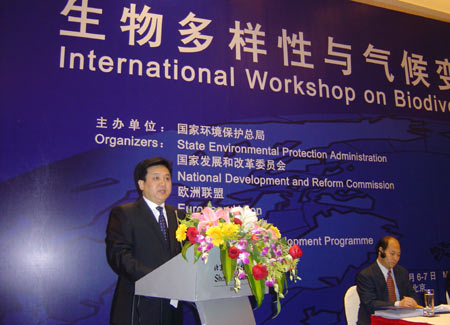In order to better guide biodiversity conservation in China, the State Environmental Protection Administration (SEPA) takes the lead in drafting China's National Biodiversity Strategic and Action Plan (NBSAP) together with other related ministries, Wu Xiaoqing, vice minister of the SEPA, disclosed on March 6 at the International Workshop on Biodiversity and Climate Change in Beijing.

Wu Xiaoqing, vice minister of the State Environmental Protection Administration
The NBSAP would be an updated version of the Biodiversity Conservation Action Plan (BCAP) that was released and implemented in the country in 1994.
According to the vice minister, the NBSAP would include seven parts, including status quo, gap analysis, strategy, priorities, etc; various sections would be drafted for special topics concerning key areas and priorities revolving around the implementation of the UN Convention on Biological Diversity (CBD) which China ratified in 1993.
Wu underscored the fact that during the drafting of the NBSAP, a special working group for climate change and biodiversity was established specifically to draft China's Strategy and Action Plan on Biodiversity and Climate Change within the framework of National Climate Change Program of China.
"The group will analyze the current situation concerning biodiversity's mitigation of and adaptation to climate change. Based on the findings it will propose priorities and a correspondent strategic and action plan with a series of ensuring measures," Wu explained at the workshop.
Home to 17,300 species of flowering plants and 667 endemic vertebrates, China is one of the most biodiversity-rich countries in the world, boasting many unique genus and species, including ancient flora and fauna and rich and rare animal species.
According to SEPA statistics, 2,395 nature reserves had been established by the end of 2006. The reserves cover 1.515 million square kilometers, accounting for 15.2 percent of China’s total land area.
Meanwhile, tree planting and reforestation projects, pollution control initiatives, and clean development mechanism programs have all actively contributed toward controlling greenhouse gas emissions and curbing biodiversity losses.
All About: biodiversity, climate change
(China.org.cn by Zhang Tingting, March 7, 2008)